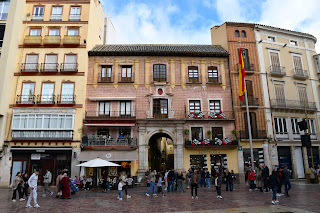A Day in Málaga
On the 26th we made a short trip to Málaga. I hesitate to call it a day trip, as we only reached the city at noon owing to forgetfulness and general malaise. We made our first stop at the Moorish Castle of Gibralfaro, which served as a good introduction to the history of Málaga. The city was founded around 770 BCE by the Phoenicians, who named it Malaka – a name that either derives from the word for salt or the word for trading post. Although the Phoenicians were the first to build fortifications on the hill overlooking Málaga, the current fortress dates to 929 when the Caliphate of Córdoba was founded. The name Gibralfaro traces its origins to this period: the first part of the name is likely a butchering of “jabal,” the Arabic word for mountain, and the latter part comes from the Greek word for light. The fortress was one of the last Moorish footholds in Spain, only falling to Ferdinand and Isabella in 1487.
Before
entering the castle, we took in the views from the lookout right underneath:
one can see the bullring of Málaga and part of the seaside right by the parking
lot. The fortress itself is not particularly interesting, but one can walk the
entire length of its ramparts and take in the views of the city as well as the
surrounding mountains. It was cloudy during our visit and the sky became
downright ugly towards the evening, which I have since learned seems to be the
case in Málaga more generally: everywhere in the area seems to have better
weather than the city itself.
Since the
Castle of Gibralfaro stands a little far from the city centre, we drove the car
down and found an underground parking lot just by the Plaza de la Merced. This
town square has an obelisk dedicated to the independence fighter General
Torrijos, who was shot in Málaga in 1831 after returning from England to fight
the French-backed absolutists. It also houses the building where Picasso was
born fifty years later.
We sat down for an extremely long lunch near the Plaza de la Merced, as the service in Spanish restaurants is painfully slow. We only left at around three o’clock with just enough time to see the remainder of the main outdoor attractions: the Fuente de Génova on the Plaza de la Constitución, the Cathedral (which we entered), the park along the promenade, and the Roman Theatre. The last of these lies right under Málaga’s Moorish palace, known as the Alcazaba, which is connected to the Castle of Gibralfaro by a walled corridor. Right in front of the theatre stands a glass pyramid, which encases an archaeological dig of basins for garum – Roman fish sauce.































Comments
Post a Comment